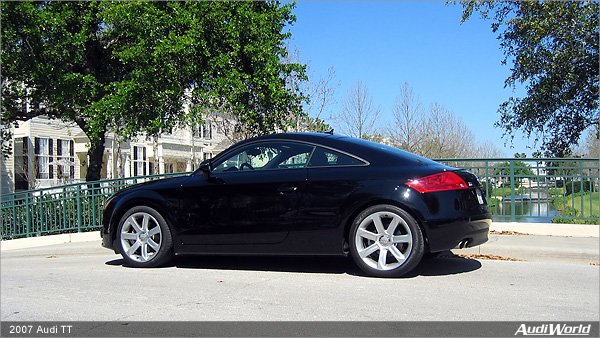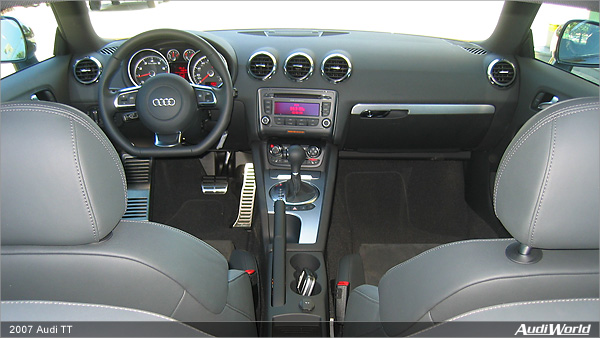TT Part Two: Sequel Success?

The original Audi TT completely ambushed the automotive world. Debuting at the Frankfurt International Auto Show in 1995, it was the car no one saw coming, least of all from Audi. The new TT delivered no such sneak attack. It was endlessly rumored, Photoshopped and illustrated (with remarkable accuracy, it turned out). Audi itself strongly hinted at the car’s design direction with its Shooting Brake concept. By the time the Mk2 premiered in Berlin last April, there were few surprises left to be revealed. Still, for some of us longsuffering TT enthusiasts, it has been an excruciating wait to see the new TT in its space frame flesh. My Christmas-morning experience finally came at the recent Chicago Auto Show. What follows are personal impressions, born of passionate familiarity with the original’s seminal design and eager anticipation of its successor’s interpretation. Sequels are notorious for underwhelming (some iterations of the Porsche 911 and VW GTI come to mind). How would this follow-up fare? The C-spot. Apart from the mandatory corporate grille, the most striking difference between first and second-generation TT coupes is the C-pillar. Gone is the sharp, laser-welded seam at the body, superceded by a continuous sweep of the roof into the rear quarter panel. The rear side window has been elongated as well, tapering to a softer corner than the Mk1. The overall contour is more sensuous to be sure, but the absence of a discernable endpoint for the roof can make the car’s haunches appear truncated from some angles. In the fold. Smooth, unbroken surfaces and simple transitions characterized much of the first generation TT’s sheet metal, as if it had been stamped in a machine shop. The new TT, in sharp contrast, looks like it has been sculpted in the artist’s studio, a product of the French curve rather than the protractor and compass. A taut power dome arcing over the hood, a rising lower sill extension, and a tight fold at the shoulder all carve out a distinct profile. The Mk2 unabashedly flaunts its creases and curves, a newfound sign of maturity. Geometry, not symmetry. Was the original TT coming or going? The front and rear ends were almost perfectly symmetrical, down to the shape of the lights. Designers of the Mk2 backed off on that strict Bauhaus esthetic. The new TT remains a study in basic geometryelemental forms elegantly realized. But headlights and taillights, front and rear fascias each go their own way, the license plate cutout subtly echoing the trapezoidal grille. The upswept headlights, especially, may be the most expressive in the Audi line. Full circle. Design-wise, the original TT literally ran circles around the competition. But how to give that a fresh spin? The Mk2 keeps the trademark circular wheel openings of the original virtually intact. Another signature element, the corners of the car are once again rounded off. Inside, Audi has reprised the circular vents, the arc of the instrument pod and the trim rings around the tach and speedo. But you won’t find a dimple anywhere. The new TT even dares to introduce new forms into the mix, like the trapezoidal indentations in the vent trim rings and the rectangular lenses of the recessed taillights. Perhaps not surprisingly, the interior feels more Audi-esque than TT-esque. Sibling revelry. Call it parts bin sharing of a high order. If you look closely, you can see that the new TT and the R8 have quite a few bits in common. The seats appear to be similar. So do the outside mirrors, gas caps, steering wheels, pedals, climate controls, inside door handles and various switchgear. This seems fitting and proper for Audi’s sports cars. One wonders if R8 buyers, at more than $100k, will appreciate the flattery. Tops, up or down. No longer an also-ran, the new roadster has emerged from Audi’s styling studio with its own identity. It steps out smartly from the shadow of its coupe sibling, eschewing the trend toward retractable roofs in favor of a traditional ragtop. The look is right, sporting a trunk lid that slopes down ever so gracefully to the edge of the retracted spoiler. In black and Luxor beige at Chicago, it was particularly stunning. Or, to be more accurate, I should say Phantom Black Pearl, a color not available initially (why does it seem that the U.S. is perpetually color-deprived by Audi?). Aluminum foil? I do take issue with some details in the new TT. The interior of the original was heavily clad in aluminum. Though many drivers won’t miss the console brace, aluminum is notably scarce in the Mk2. What there is of it Audi has labeled “aluminum optic” or “aluminum look” or “aluminum.” Which is it, really? I suspect aluminum-painted plastic for most pieces. To borrow a phrase from another German marque, “there is no substitute.” Maybe Audi was thinking that an aluminum chassis is more than enough compensation. Cost cutting is also evident in the hatch/trunk area. Where the original TT was swathed in a velour-like fabric reminiscent of classic automobile upholstery, the Mk2 is covered in a fuzzy felt very unbecoming of Audi. Perhaps the enhanced interior package, which was not on the TT I viewed, will upgrade this. The same, but different. Audi has even restyled the TT’s logo. Can you spot the update? I lusted after the original TT from the first, so taken with the purity of its execution. I’ve owned three of them, despite the ponderous handling of its humble Golf IV chassis. The TT is a car to wear as much as to drive, an Armani suit shod with Pirellis. The TT Mk2 cuts a far sleeker figure. Audi has shaped an emotional, respectful evolution, a worthy spiritual successor that is still instantly recognizable as a TT. The capable Golf V chassis, combined with the ASF body, should make it a driver’s car, not just a designer’s car. And the more muscular stance, along with newly ripped flanks, should assure that Mk2 drivers will not have to endure the “compliment” that makes all of us TTers wince: “Cute car!” So far, the Mk2 has been opening to favorable reviews, at least among those who have driven it on European roads. The ultimate verdict from testing a U.S.-spec car here at home has yet to be delivered. In the meantime, to this admittedly biased critic’s eye, the new TT is one sequel that never merely follows.
|

